In the 1860s the unincorporated town of Kentfield, which sits in the lower Ross Valley, was affectionately called Tarantulaville by locals. The name comes . . .
East Marin stories tell what could have been on the coast


In the 1860s the unincorporated town of Kentfield, which sits in the lower Ross Valley, was affectionately called Tarantulaville by locals. The name comes . . .